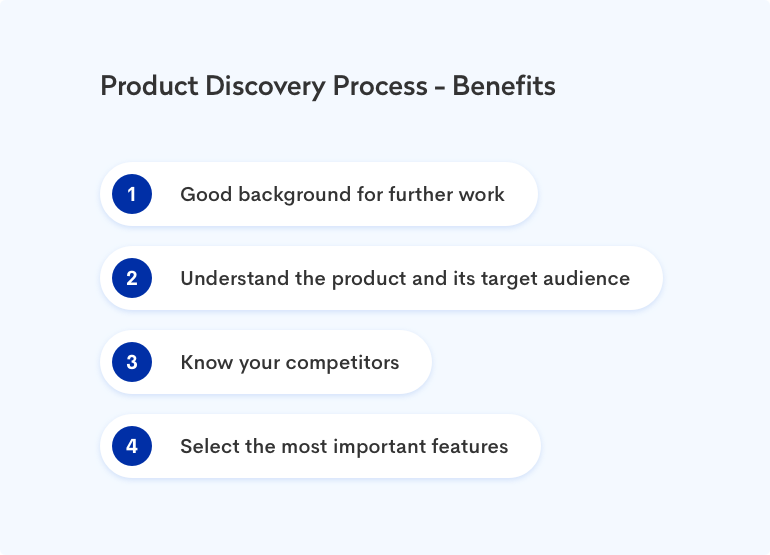Why the Product Discovery Process Increases the Chances of Your Project’s Market Success
Product discovery is one of the first stages of application development, making it easier to understand the client’s expectations and identify users’ needs. What should you consider during the product discovery process to make your project successful?
One of the main benefits of product discovery is the opportunity to understand the project requirements. This is the time to determine the target audience and its size and needs, as well as the most important features of the application and the conditions under which it should be used. Verifying the idea at an early stage and understanding the users are the first steps to creating an application that delivers real value.
Read on to find out how our product discovery workshops can help you stay ahead of the competition.
Table of Contents
What is product discovery?
Product discovery is one of the stages of our workshops that helps to identify and structure customer requirements. Its main goal is to understand the customer’s needs and expectations, which in turn helps to convert requirements and business assumptions into product performance.
Our workshops are divided into several phases, which, besides product discovery, include event storming, user journey mapping, application prototyping and estimation. The type, duration and location of the workshop (which can also be conducted remotely) are determined individually, depending on the client’s needs.
Product discovery is a process that facilitates understanding real problems and users’ needs before starting product development. This approach minimizes the risks of unnecessary costs or launching a product that doesn’t meet the requirements of the target group.
Product discovery workshop step by step
At this stage of the process, the main goal is to gather as much information as possible about the market, the target group and the competition. Doing so helps to verify the business idea, which makes it easier to decide whether it’s worth investing time and money in.
There is no one set pattern to follow in the product discovery process. Our workshops may vary slightly depending on the chosen methodology or overall product strategy, but we always stick to the same principles and structure you’ll find below.
- Explore and understand the product idea
The workshop starts with a casual conversation, allowing us to better understand the idea, the project and the requirements. This step is essential in order to figure out the client’s expectations, so we can’t skip it.
- Specific questions
Once the initial details have been gathered, it’s time for us to examine the exact client requirements. The easiest way to learn about client needs is to ask them directly, so this is the stage where we ask specific questions such as:
- Who is the application’s target user?
- What are the types of application users?
- Will the product be created for the domestic market or will it also be available abroad?
- How often do users interact with the platform?
- What devices are most often employed by the platform’s users – smartphone, tablet, computer?
- What functionalities will be used most often and why?
- How well do users know the available technologies? (This question allows you to refine the complexity level of the application.)
Before the workshop, we ask the client to think about their business needs and send them a list of questions that will make it easier to prepare the features they want the most.
- Meeting summary
The final step of the product discovery phase is gathering and summarizing the information provided, along with the insights learned, and documenting the project’s scope and vision.
This approach facilitates further product development. The product discovery workshop is the initial phase of a comprehensive product workshop with steps leading to project implementation. This is why it’s so important to focus on product discovery, increasing the chances of success and, most importantly, avoiding extra costs.
Product discovery is also a great opportunity to analyze the competition – focus on their strengths and weaknesses, the tools and solutions they use, and how you can learn from them.
Why conduct a product discovery process?
The time allocated for product discovery can deliver many benefits in later development stages. Here’s a list of the main advantages.
- Good background for further work
The know-how gained during the workshop makes it easier to define project requirements, thanks to a clearer understanding of the target group’s needs. This allows for effective prioritization and accelerates the next stages of work.
- Know your competitors
Before you set goals and priorities, it’s good to find out what opportunities lie in your target market. Assessing the strengths and weaknesses of companies that offer similar products allows you to understand how your intended application differs from others available on the market and confirm the unique value you deliver. This in turn can translate into a winning competitive advantage.
- Understand the product and its target audience
Product discovery inspires your team to question their own assumptions and think outside the box. This helps validate an idea against market requirements and ensures that the app solves real problems for potential users.
- Select the most important features
The product discovery phase simplifies the verification of functionalities that will be used most often and generate the most revenue. This way, the team knows from the beginning what to focus on in order to create a product that gives real value to the users. If the product discovery phases are conducted properly, the necessary features will naturally emerge.
What’s next?
Product discovery is the first stage of the product workshop, but its main goal is a deeper understanding of business needs and requirements. This enables you to prepare a solid foundation for an application that will meet your business objectives and start generating profits quickly.
The knowledge gained about the project and whether the application meets the expectations of the target group can give you the green light to start the implementation phase. You can then move forward with confidence and build an MVP to maximize your return on investment.
Do you want to verify your product idea, or wonder whether it’s worth implementing specific functionalities? Contact us: we’re always happy to help!







